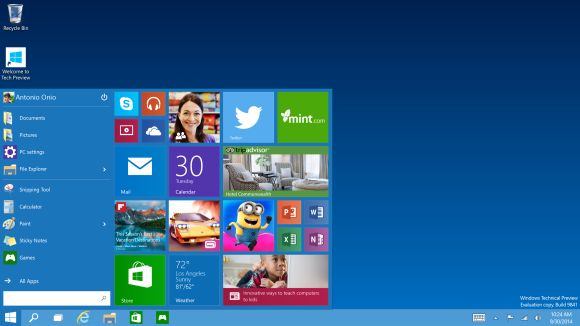The software giant that brought us the joy of Windows XP and 7, to the despair of Vista is at it again. Hither came Microsoft’s Windows 10, which will succeed the current Windows 8.1. Microsoft had made a strange choice of skipping a number, instead of naming it Windows 9. Windows 10 will be made to run across all existing devices and hardware that is already running Windows, such as mobile devices, laptops and desktops.
The one thing that everyone was hoping for is confirmed. The Start Menu will be coming back, that one button on the left that made sense out of everything, unlike Windows 8, where the design and structure made computers that did not have a touchscreen seem ridiculous. This is not a complete rework, but more of a remodeling. The Start Menu will practically be more or less the same, but the difference of having live tiles integrated on to the Start Menu, which reminds us very much of a Windows Phone or Tablet interface. The tiles will still be live in real time, with the option to resize and rearrange them.
A New Windows with a familiar face

Although new features will be accessible, some old features and design are retained, especially for those who really prefer an interface that’s more for touch. The Charms bar is one of them, which allows users to access Task View by simply swiping from the left of the screen. Another smart feature that Windows 10 will have is the smart ability to alternate between touch and keyboard interfaces, based on device. If when on touch, buttons and tiles will enlarge for more touch accuracy, something that was seen much earlier on Windows 7.
Multi-tasking made easy
Windows 10 has a new approach to how multitasking is done. The first is Snap, where you can have up to four apps “snapped” on the same screen in a single quadrant layout. Other apps that you have running can be seen via gesture, with the option for snapping them additionally, along with smart suggestions on available space on the screen that can be filled. Multi-tasking can now be viewed and launched by simply pressing a button from the taskbar, allowing multiple desktops to be run with apps open simultaneously. This is a sight for sore eyes, as this feature was not present on Windows 8.1, due to their full screen apps and swapping between them were too slow.
Microsoft has launched their Windows Insider Program, allowing signees to test out a preview of Windows 10 on their laptops and desktops. Although they have mentioned that Windows 10 will also be for smartphones, there were no screenshots or previews on the outlook, but one thing’s for sure is that it will not have a desktop. Windows 10 will be expected to ship upcoming 2015, with possibilities of a free upgrade for existing 8.1 users.
Windows 10 looks exciting, and would certainly decrease the likelihood of people poking non-touchscreen computers thinking that it is a touchscreen just because it has Windows 8.1 loaded on it.
[ SOURCE ]







